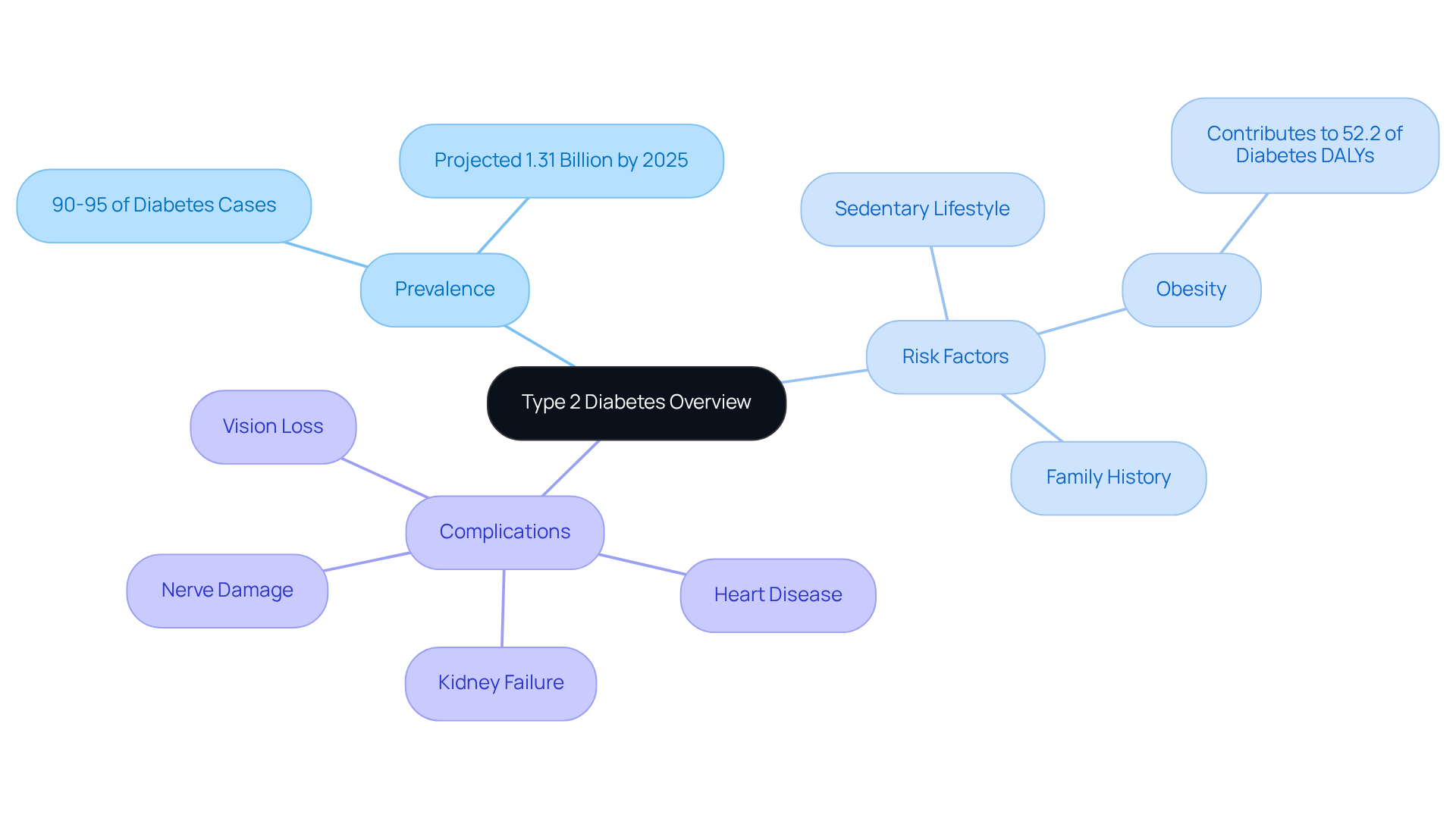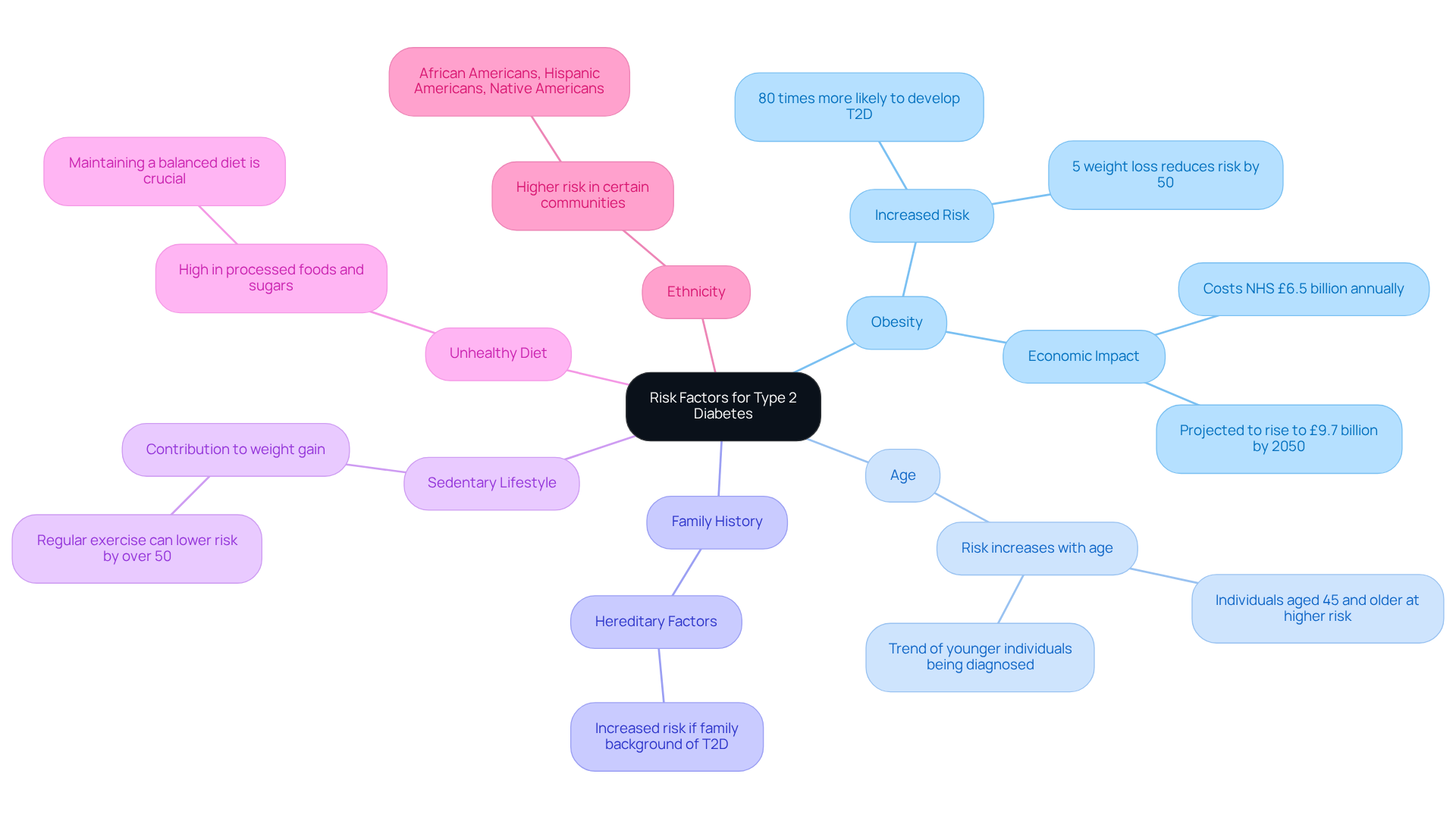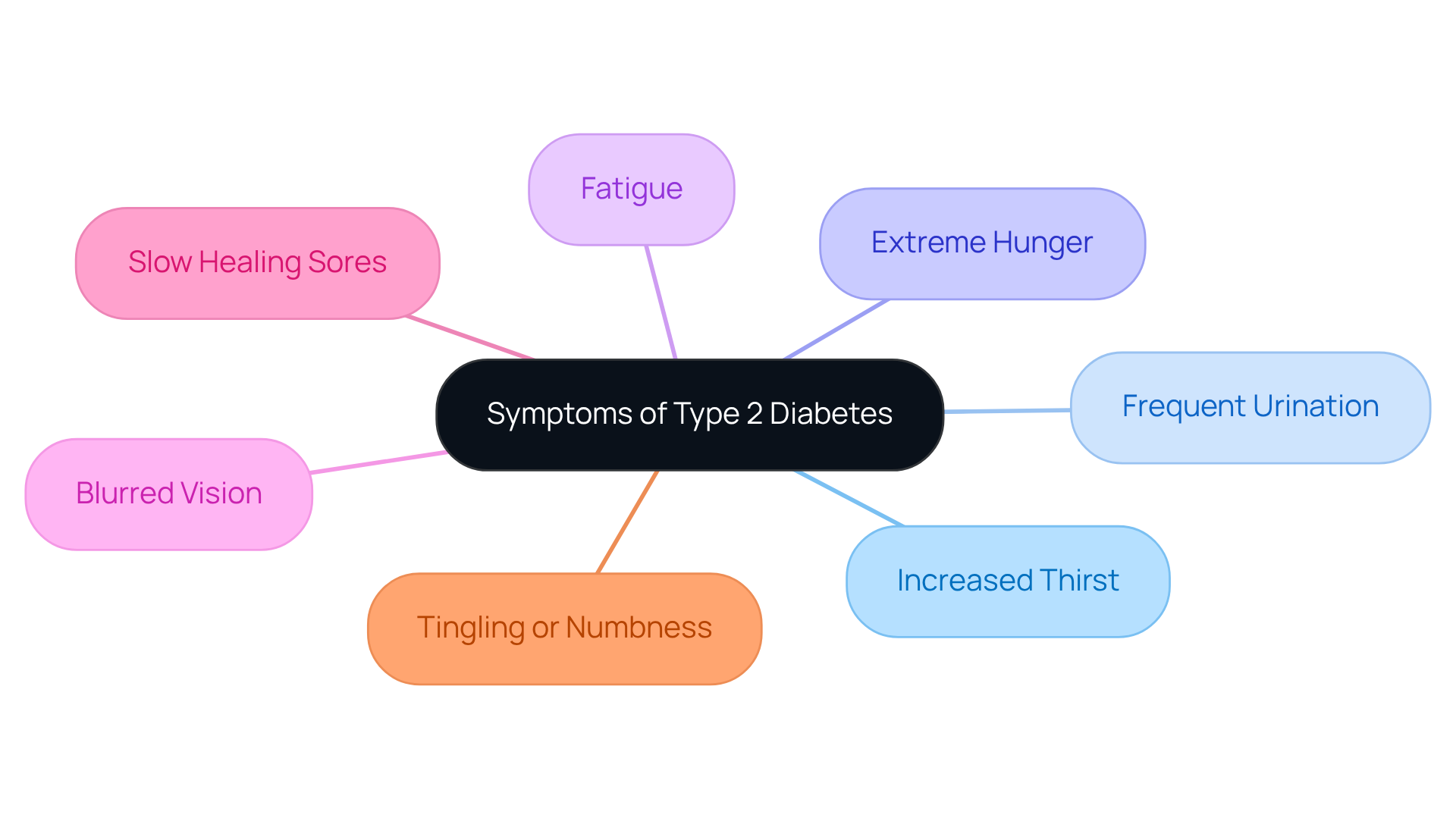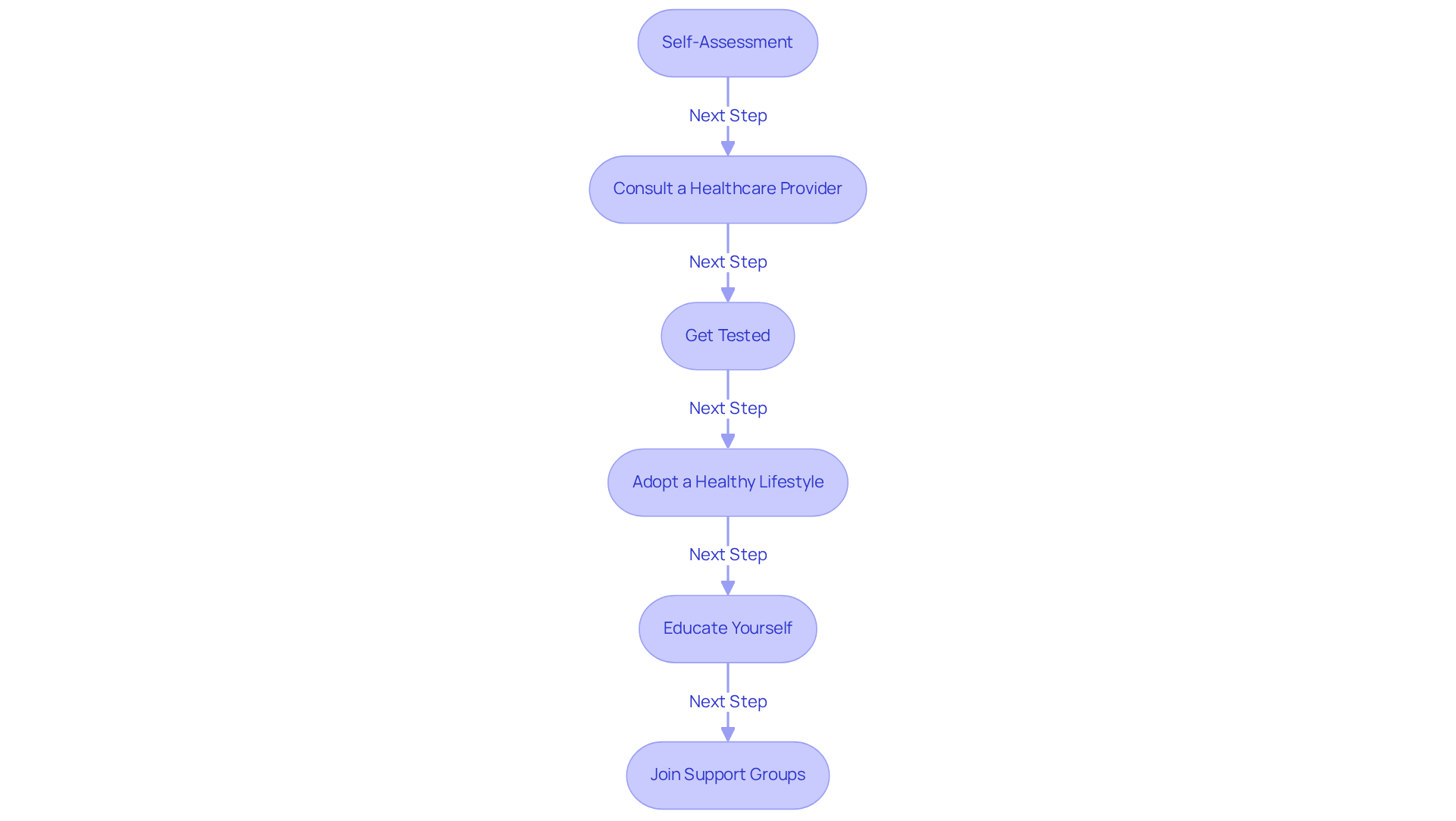Overview
Understanding the risk factors and symptoms of Type 2 diabetes is essential for your health. Key indicators include:
- Obesity
- A sedentary lifestyle
- Family history
- Age (especially for those 45 and older)
- Unhealthy dietary habits
Recognizing these factors can empower you to take charge of your health.
It's important to be aware of symptoms such as:
- Increased thirst
- Fatigue
These signs can be your body's way of communicating that something needs attention. Early intervention is crucial, as it can lead to effective management of the condition and significantly reduce the likelihood of serious health complications.
Remember, you're not alone in this journey. We are here to support you every step of the way. If you identify with any of these risk factors or symptoms, consider reaching out for resources or support. Taking action now can lead to a healthier future.
Introduction
Understanding the looming threat of type 2 diabetes is crucial, especially as global statistics project that over 1.31 billion individuals will be living with this condition by 2025. It's understandable to feel concerned about these numbers. This article delves into the key risk factors and symptoms associated with type 2 diabetes, offering you valuable insights into who might be at risk and how you can take proactive steps toward prevention and management. As the prevalence of this chronic illness rises, the pressing question remains: what can you do to identify your risk and safeguard your health against this potentially debilitating condition?
Remember, you're not alone in this journey, and we are here to support you every step of the way.
Understand Type 2 Diabetes: Key Facts and Overview
Form 2 of the ailment is a long-lasting condition that can significantly interfere with your body's ability to process glucose, which is an essential energy source. Unlike form 1, where insulin production is lacking, form 2 arises when the body develops resistance to insulin or does not produce enough of it. This can lead to elevated blood sugar levels, potentially resulting in serious health complications if not managed effectively.
At T2DSolutions, we are dedicated to providing extensive resources and support for individuals navigating their health journey. By understanding the following crucial information, you can better assess who's at risk for type 2 diabetes and take proactive steps toward the prevention and management of this condition.
Key facts to consider:
- Prevalence: Type 2 Diabetes accounts for approximately 90-95% of all diabetes cases worldwide. It is projected that by 2025, over 1.31 billion individuals will be living with this condition, with Type 2 being responsible for the vast majority of these cases.
- Risk Factors: Major risk factors for those who's at risk for type 2 diabetes include obesity, which contributes to nearly 52.2% of global diabetes-related disability-adjusted life years (DALYs), a sedentary lifestyle, and a family history of this condition. Obesity trends are expected to contribute to nearly half of the increase in prevalence by 2050.
- Complications: If left unmanaged, this condition can lead to serious complications, including heart disease, kidney failure, nerve damage, and vision loss. In 2021, diabetes was the direct cause of 1.6 million deaths, underscoring the critical importance of early detection and effective management strategies.
We encourage you to subscribe to T2DSolutions for updates and resources that can assist you in understanding and managing your condition effectively. Remember, you're not alone in this journey; we are here to support you every step of the way.

Identify Risk Factors: Who is Most at Risk?
Understanding the factors that contribute to form 2 of the disease is essential for proactive health management. At T2DSolutions, we are dedicated to empowering individuals with the knowledge and resources they need to manage their health effectively. Here are some key contributors to the risk of developing Type 2 Diabetes:
- Obesity: Excess body fat, especially around the abdomen, significantly increases the risk of developing Type 2 Diabetes. Research shows that individuals with obesity are up to 80 times more likely to develop this condition compared to those with a BMI under 22. It's understandable to feel concerned about this statistic, but knowledge is the first step toward action.
- Individuals aged 45 and older are among those who are at risk for type 2 diabetes, as the likelihood of developing this condition increases with age. However, there is a troubling trend where more individuals in their 30s and 40s are receiving a diagnosis. Recognizing this can help us understand the importance of early intervention.
- If you have a family background of Type 2 Diabetes, you may be among those who are at risk for type 2 diabetes. This highlights the significance of hereditary factors in vulnerability, reminding us that we are not alone in our journey.
- Sedentary lifestyles contribute to weight gain and insulin resistance, which are significant factors in determining who is at risk for type 2 diabetes. Engaging in regular physical exercise can lower the occurrence of this condition by over 50%. Remember, every small step counts!
- An unhealthy diet, which is high in processed foods, sugars, and unhealthy fats, is linked to individuals who are at risk for type 2 diabetes. Maintaining a balanced diet is crucial for keeping a healthy weight and preventing diabetes. You have the power to make healthier choices.
- Certain ethnic communities, including African Americans, Hispanic Americans, and Native Americans, are groups who are at risk for type 2 diabetes. This calls for focused public health initiatives to support these communities.
By recognizing these risk factors, you can take informed actions toward a healthier lifestyle, potentially lowering your risk of developing Type 2 Diabetes and understanding who is at risk for type 2 diabetes. Remember, you're not alone in this journey. For more resources and support, subscribe to T2DSolutions to stay updated on diabetes management and education. We are here to support you every step of the way.

Recognize Symptoms: Early Signs of Type 2 Diabetes
Prompt identification of condition two can lead to better management and help avoid complications. It's important to be aware of common symptoms that may arise, as recognizing these can be the first step toward feeling better. Here are some signs to watch for:
- Increased Thirst: A persistent feeling of thirst that doesn’t seem to go away.
- Frequent Urination: Needing to urinate more often than usual, especially at night.
- Extreme Hunger: Feeling very hungry even after eating.
- Fatigue: Experiencing unusual tiredness or a lack of energy.
- Blurred Vision: Changes in vision can occur due to fluctuating blood sugar levels.
- Slow Healing Sores: Cuts and bruises that take longer to heal than normal.
- Tingling or Numbness: Particularly in the hands or feet, which can indicate nerve damage.
If you experience any of these symptoms, it’s completely understandable to feel concerned. Please know that consulting a healthcare provider for further evaluation is a crucial step. Remember, you're not alone in this journey; we are here to support you every step of the way.

Take Action: Steps to Assess Your Risk and Seek Help
Taking proactive measures to evaluate who's at risk for type 2 diabetes is essential for early intervention. You are not alone in this journey, and there are actionable steps you can take to protect your health:
-
Self-Assessment: Begin by utilizing online evaluation tools, such as the American Diabetes Association's assessment test, to gauge your vulnerability level. These tools often incorporate various factors, including age, family background, and lifestyle choices, to provide a comprehensive assessment of who's at risk for type 2 diabetes.
-
Consult a Healthcare Provider: It's understandable to feel uncertain about your health. Arrange a meeting with your doctor to discuss your health factors and any symptoms you might be experiencing. Recent recommendations suggest that adults who's at risk for type 2 diabetes should start evaluations for health concerns related to high blood sugar at age 45, or sooner if they have other contributing factors.
-
Get Tested: Consider requesting blood tests to check your blood sugar levels, including fasting glucose and A1C tests. Regular testing is crucial, as studies show that early detection can lead to better management outcomes. Remember, knowledge is empowering.
-
Adopt a Healthy Lifestyle: Focus on maintaining a balanced diet, engaging in regular physical activity, and managing your weight. Evidence suggests that lifestyle changes can significantly lower the chances for individuals who's at risk for type 2 diabetes. Small steps can lead to big changes.
-
Educate Yourself: Take advantage of resources from reputable organizations like T2DSolutions to learn more about managing and preventing this condition. The more you know, the better equipped you are to take charge of your health.
-
Join Support Groups: Connecting with others who are dealing with blood sugar issues can be incredibly beneficial. Share experiences and strategies with those who understand your journey. Community support can enhance motivation and provide valuable insights.
By taking these steps, you can significantly reduce your risk and improve your overall health. Engaging with healthcare providers and utilizing available resources is vital in navigating your diabetes journey. Remember, we are here to support you every step of the way.

Conclusion
Understanding the risk factors and symptoms associated with type 2 diabetes is crucial for effective prevention and management. This condition affects a significant portion of the global population and can lead to severe health complications if not addressed promptly. By recognizing the signs and understanding who is most at risk, individuals can take proactive steps toward safeguarding their health and well-being.
The article highlights essential insights into the prevalence of type 2 diabetes. It emphasizes that:
- Obesity
- Age
- Family history
- Lifestyle choices
are major contributors to risk. Additionally, it outlines common symptoms that should not be ignored, as early detection can lead to better management outcomes. Actionable steps, such as:
- Self-assessment
- Consulting healthcare providers
- Adopting a healthier lifestyle
are vital for those looking to reduce their risk.
Ultimately, raising awareness about type 2 diabetes and its associated risks is a collective responsibility. It's understandable to feel overwhelmed, but by staying informed and taking proactive measures, individuals can empower themselves to make healthier choices and seek support when needed. Engaging with resources like T2DSolutions can provide valuable knowledge and community support, making the journey toward diabetes management a shared experience. Remember, you're not alone in this journey; we are here to support you every step of the way.
Frequently Asked Questions
What is Type 2 Diabetes?
Type 2 Diabetes is a long-lasting condition that affects the body's ability to process glucose, leading to elevated blood sugar levels. It occurs when the body develops resistance to insulin or does not produce enough insulin.
How does Type 2 Diabetes differ from Type 1 Diabetes?
Unlike Type 1 Diabetes, which involves a lack of insulin production, Type 2 Diabetes is characterized by insulin resistance or insufficient insulin production.
What percentage of diabetes cases worldwide does Type 2 Diabetes account for?
Type 2 Diabetes accounts for approximately 90-95% of all diabetes cases worldwide.
What are the projected statistics for Type 2 Diabetes by 2025?
It is projected that by 2025, over 1.31 billion individuals will be living with Type 2 Diabetes.
What are the major risk factors for developing Type 2 Diabetes?
Major risk factors include obesity, a sedentary lifestyle, and a family history of diabetes. Obesity contributes to nearly 52.2% of global diabetes-related disability-adjusted life years (DALYs).
What complications can arise from unmanaged Type 2 Diabetes?
Unmanaged Type 2 Diabetes can lead to serious complications such as heart disease, kidney failure, nerve damage, and vision loss.
How many deaths were directly caused by diabetes in 2021?
In 2021, diabetes was the direct cause of 1.6 million deaths.
What resources does T2DSolutions offer for individuals with Type 2 Diabetes?
T2DSolutions provides extensive resources and support to help individuals understand and manage their condition effectively.



